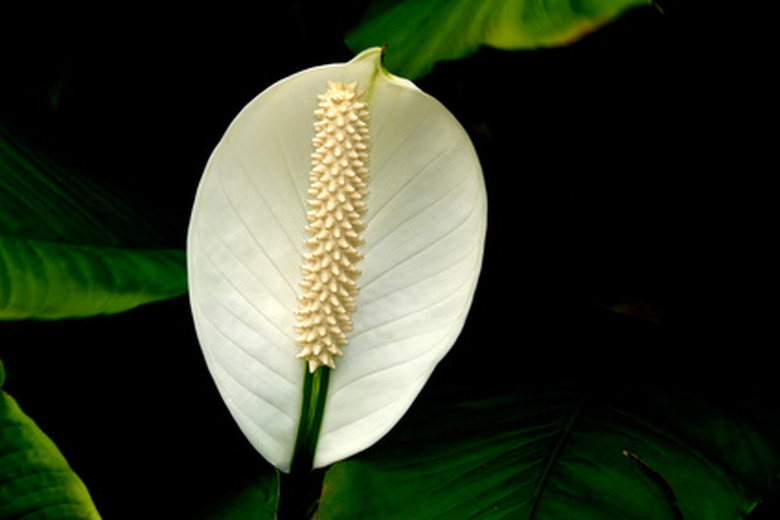How To Grow Peace Lilies Outdoors In Florida
Things Needed
- Garden shovel
- Well-rotted compost or tree bark
- Peat moss
- Containers or planter boxes
- Slow-release garden fertilizer
- Bark mulch
Spathiphyllum, or peace lilies, are herbaceous members of the family Araceae. Most Aroids are tropical plants and several, including monstera, anthurium, philodendron and caladium, are familiar indoor house plants. Peace lilies are native to the tropics of Central America but can be grown outdoors on the southern coast of Florida from Miami around the Keys to Fort Myers, provided that they are protected from temperatures below 55 degrees during the cool season. They make an impressive ground cover for shady areas.
Step 1
Prepare planting areas in shady areas for ground covers in above-ground containers on shaded porches and decks or in doorways. The Mid-Florida Research and Education Center of the University of Florida recommends planting peace lilies in soil that does not fall below 65 degrees. Plant them where they can be easily protected or moved if your winter nighttime temperatures fall below 55 degrees. Plant peace lilies any time of year, as they have no dormancy requirements.
- Spathiphyllum, or peace lilies, are herbaceous members of the family Araceae.
- Plant peace lilies any time of year, as they have no dormancy requirements.
Step 2
Cultivate the soil to a depth of about a foot, adding peat moss or well-rotted compost to Florida's sandy loam. Oglesby Plants International recommends an acidic soil pH of 5.8 to 6.5 for best growth and suggests a potting mix of peat, perlite and rotted bark with for container plants.
Step 3
Plant spathiphyllum 24- to 36-inches apart for ground cover or on box containers with bottom drainage. Set the plants into the ground at the same height as they sit in their nursery pots.
Step 4
Water spathiphyllum well as soon as they are planted and allow them to begin to droop before you water them again. Too much water can rot roots, and you'll need to observe your new plants carefully for a while to judge when they need water.
Step 5
Fertilize peace lilies with a slow release garden fertilizer. Oglesby recommends working a dry slow-release formula into soil when planting or watering weekly with a liquid fertilizer with an N-P-K (Nitrogen, Phosphorus, Potassium) ratio of 3:1:2.
- Cultivate the soil to a depth of about a foot, adding peat moss or well-rotted compost to Florida's sandy loam.
- Oglesby recommends working a dry slow-release formula into soil when planting or watering weekly with a liquid fertilizer with an N-P-K (Nitrogen, Phosphorus, Potassium) ratio of 3:1:2.
Tip
Mulch your peace lilies with an inch of shredded bark or other natural mulch for appearance and to keep to keep the peat-rich soil in place. Peace lilies mature fast and will be ready to divide within a year or two of planting. One-year-old plants should begin to bloom during early spring and bloom intermittently throughout the year. Peace lilies are not native plants in South Florida, but they are easily grown in tropical areas. According to the Florida Exotic Pest Plant Council, they show no signs of becoming invasive so they are safe to use in outdoor ground covers.
Warning
Spathiphyllum are not salt tolerant, so avoid planting them areas exposed to sea breezes. Peace lilies like bright shade, but direct sunlight will burn their foliage.
